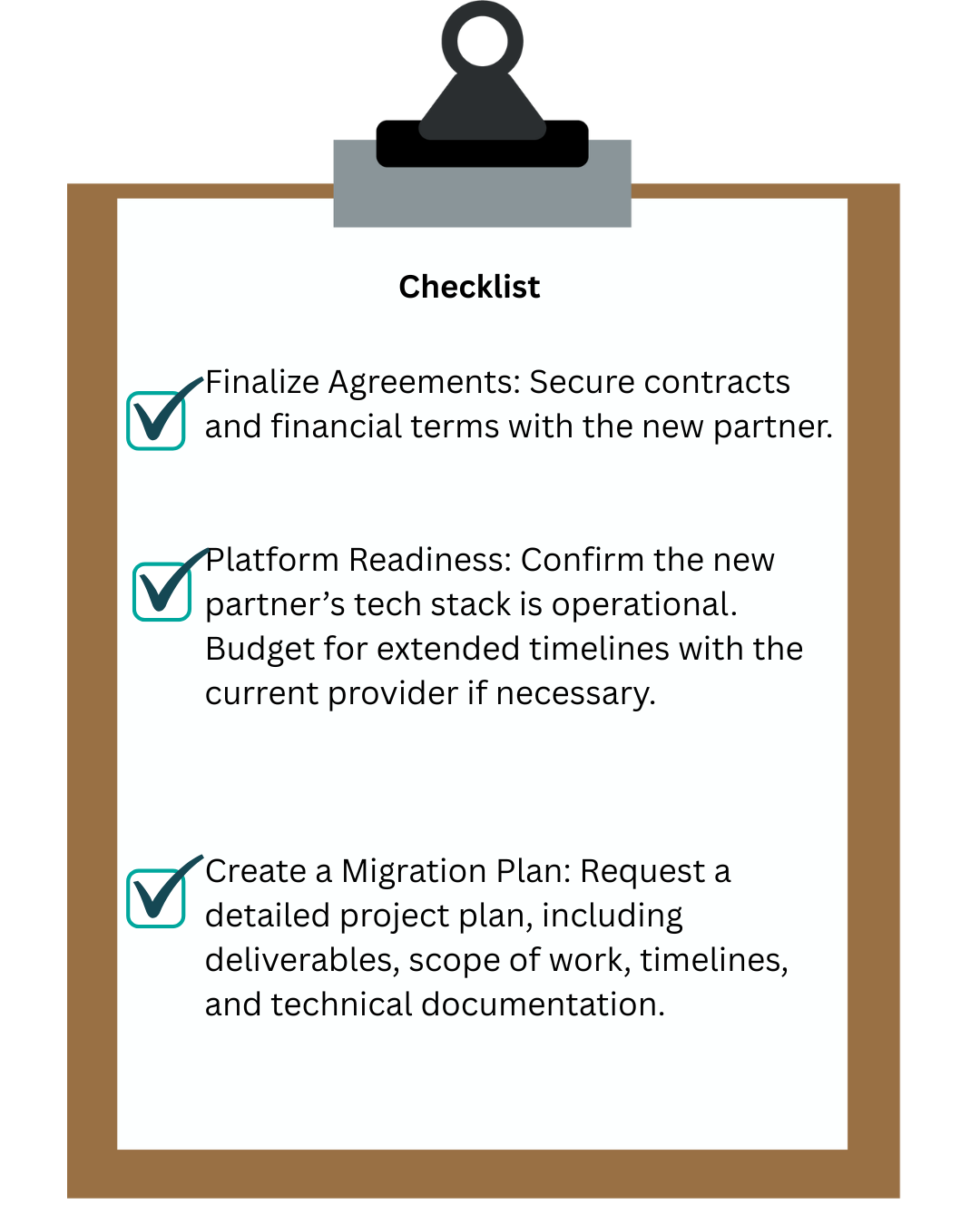Rules and relationships evolve, often ending as circumstances change — so why cling to permanence in the world of business? In a rapidly advancing, interconnected landscape, fresh technologies, platforms, and systems surface every day, each crafted to make our lives more efficient and our work smarter. Embracing this constant evolution is no longer a choice; it’s an opportunity.
Sometimes, newer services offer better efficiency, cost-effectiveness, and enhanced performance, making the switch worthwhile. The reasons for changing a service provider, team member, company, vendor, or partner vary. Some changes are proactive, while others are reactive under pressure. Ultimately, flexibility is key, and our options should reflect that freedom.
This is especially true in the telecommunications industry, where advancements in systems and infrastructure play a pivotal role in maintaining growth and competitiveness.
Large-Scale Transitions
1. BSS (Business Support Systems) Transitions
-
- Possibilities: Upgrading critical systems such as billing platforms, customer relationship management (CRM) tools, and revenue assurance systems to cloud-native solutions. These upgrades enhance scalability, improve operational efficiency, and support complex pricing models for diverse customer needs.
- Example: A telecom operator transitioned its legacy billing system to Oracle Communications Billing and Revenue Management. This migration enabled the operator to handle increased subscriber demands, implement flexible pricing structures, and streamline revenue management processes.
2. OSS (Operational Support Systems) Transitions
-
- Possibilities: Modernizing operational systems like network management, service provisioning, and fault management platforms to support advanced technologies such as 5G and IoT. These upgrades improve network performance, reduce downtime, and enable predictive maintenance.
- Example: African telecom operators integrated AI-driven analytics into their OSS platforms. This modernization allowed them to optimize network performance, proactively address faults, and enhance service reliability for customers.
3. Enabler Transitions
-
- Possibilities: Migrating to advanced enabler platforms for SIM provisioning, subscriber management, and service activation. These platforms offer greater flexibility, scalability, and automation to support growing subscriber bases and new service offerings.
- Example: Ting Mobile adopted a cloud-native enabler platform, enabling it to scale operations efficiently, improve service activation times, and enhance overall customer experience.
4. Global Network Expansion
-
- Possibilities: Expanding network coverage by forming partnerships with international carriers or deploying multi-IMSI (International Mobile Subscriber Identity) technology. This ensures seamless roaming and connectivity for customers across borders without requiring additional infrastructure.
- Example: An MVNO partnered with global carriers to provide international roaming services. By leveraging multi-IMSI technology, the MVNO ensured uninterrupted connectivity for its customers while minimizing operational costs.
Smaller-Scale Projects
1. Website Transitions
-
- Possibilities: Redesigning websites to enhance user experience, integrate e-commerce capabilities, and improve mobile responsiveness. These updates can also include features like AI-powered chatbots for customer support.
- Example: A telecom company revamped its website to include AI-driven chatbots, enabling faster customer query resolution and a more interactive user experience.
2. SMS Provider Upgrades
-
- Possibilities: Switching SMS gateways to improve message delivery rates, reduce operational costs, and enable advanced features like two-factor authentication (2FA) and personalized notifications.
- Example: An MVNO upgraded its SMS provider to Twilio, which offered better scalability, improved integration with CRM systems, and enhanced message delivery reliability.
3. CRM Transitions
-
- Possibilities: Migrating to a new CRM platform to streamline customer interactions, improve data analytics, and enable better marketing automation. These transitions help businesses personalize customer experiences and optimize sales processes.
- Example: A telecom operator transitioned from Salesforce to HubSpot, leveraging HubSpot’s advanced marketing automation tools to enhance customer engagement and drive sales growth.
4. Mobile App Enhancements
-
- Possibilities: Updating mobile apps to include new features such as self-service portals, payment gateways, personalized recommendations, and usage insights. These enhancements improve customer satisfaction and engagement.
- Example: An MVNO added AI-driven usage insights to its mobile app, allowing customers to monitor their data usage, receive personalized plan recommendations, and manage their accounts more effectively.
When Should You Consider an Upgrade or Transition?
To ensure your services align with your business goals and customer needs, evaluate them against the following criteria. The more boxes you tick, the stronger the case for adopting or upgrading the service:
1. Cost Efficiency:
Prioritize cost savings and a higher return on investment (ROI).
2. Quality of Service (QoS):
Balance affordability with quality to avoid compromising your reputation for a cheaper option.
3. Scalability:
Your platforms must support growth in user base and international reach—don’t let outdated systems limit your potential.
4. Technology Upgrades:
Stay competitive by embracing cutting-edge innovations like AI, analytics, and automation.
5. Geographic Availability:
A global reach is vital, but local presence adds personal connection.
6. Compliance and Security:
Essential for safeguarding your operations and reputation.
7. Flexibility and Customization:
Business models evolve constantly; your services should adapt alongside them.
8. Feedback and Reputation:
Choose partnerships that enhance your market position and foster trust.
(There may be instances where the need to upgrade or enhance your business operations, strategy, and ROI is not driven by your own proactive decisions. Instead, it may arise from challenges with a partner who is underperforming or no longer aligning with your business goals, vision, and strategy. Such situations can be delicate and require careful handling. Recognizing these misalignments early is crucial, as they can impact the overall trajectory of your business. Addressing these issues with sensitivity, open communication, and a clear plan of action should be a priority to ensure the long-term success and harmony of your operations.)
MVNO’s have done it!
MVNE Partnerships and Cloud-Based Migrations MVNOs often migrate their enablers or core networks by partnering with different Mobile Virtual Network Enablers (MVNEs). These migrations allow MVNOs to utilize cloud-based infrastructures, improve scalability, and offer innovative services. Here are some examples:
- Ting Mobile: Ting Mobile operates on networks like Verizon and T-Mobile and has adopted cloud-native systems to enhance flexibility and scalability.
- Amazon’s MVNO Initiative: Amazon partnered with DISH Wireless to provide mobile services bundled with Amazon Prime, leveraging cloud-based infrastructure for seamless integration and innovation.
- Tesco Mobile: Tesco Mobile integrated cloud-based solutions to streamline its operations and improve customer experience, ensuring a more efficient and scalable service offering.
The preparation
Before you begin, its vital to map out all parties readiness, this could lead to substantial delays and or end customer impacts.
Is Your Partner Ready?
-
- Is their product and tech stack ready for integration?
- Do they have resources available to assist?
- What’s their timeline for completing the project?
Are You Ready?
-
- Can your platform support both the existing and new provider during the transition?
- Have you reviewed termination clauses with your current provider? Ensure the new provider is ready to go before giving notice.
- Are you prepared for possible downtime during migration? Have contingency plans in place.
Checklist for a Smooth Migration

Final Considerations
For large-scale migrations like moving enablers or subscriber bases, focus on meticulous project management and contingency planning.
Large-scale migrations might involve moving enablers, subscriber bases, or core networks from one provider to another. Key considerations include:
1. Project Management:
Develop a detailed project plan with clearly defined milestones, timelines, and deliverables.
2. Testing & Validation:
Conduct extensive pre-migration testing to ensure functionality and compatibility across systems.
3. Data Integrity:
Ensure secure and accurate transfer of sensitive data, such as subscriber records and billing information.
4. Scalability:
Confirm the new systems can handle existing loads and future growth without performance bottlenecks.
5. Downtime Planning:
Plan for possible service interruptions during the migration and communicate proactively with stakeholders.
6. Stakeholder Involvement:
Engage all relevant teams—technical, legal, and customer service—to avoid oversight and ensure smooth execution.
7. Backup & Recovery:
Maintain backups of critical data and systems to safeguard against failures or unexpected errors.
For smaller transitions—such as switching service providers for websites, CRMs, or applications—the process is generally quicker but still requires attention to potential challenges. Smaller migrations, such as switching service providers for websites, CRMs, or applications, are quicker and less complex but still require attention to detail. Key considerations include:
1. Compatibility Check:
Verify that the new service integrates seamlessly with your current systems and workflows.
2. Minimal Disruption:
Ensure the migration doesn’t impact day-to-day operations or customer experience.
3. Resource Allocation:
Allocate sufficient resources for the migration without overburdening your teams.
4. Cost Analysis:
Assess whether the migration provides a measurable return on investment (ROI).
5. Training & Onboarding:
Provide training for staff to familiarize them with the new systems or services.
6. Quick Testing:
Perform basic functionality checks to confirm successful migration.
7. Exit Strategy:
Ensure contracts with the current provider are terminated smoothly without penalties or negative impacts.
From Challenges to Opportunities
Transition is far more than just change—it embodies growth, evolution, and boundless opportunity. Having personally navigated the intricate process of transitioning enablers, tech stacks, and service providers, I’ve witnessed firsthand the profound impact this can have on business models and personal learning. Along the way, there have been valuable lessons and insights, stemming from both challenges and triumphs.
Challenges of Transitions:
-
- Service Provider Unavailability:
Unanticipated delays caused by holidays or uncommunicated events disrupted timelines and hindered project execution. - Miscalculated Task Durations:
Underestimating timelines forced team members to stretch across multiple roles, often leading to exhaustion with long hours and minimal rest. - Overpromised Delivery Timelines:
Commitments from product procurers and vendors fell short, creating a domino effect across processes. This led to simultaneous task executions, resource burnout, and reliance on emergency funds to mitigate delays.
- Service Provider Unavailability:
Successes of Transitions:
-
- Cost Optimization:
Substantial cost savings strengthened profitability and operational efficiency. - Access to Cutting-Edge Technology:
Adoption of the latest innovations enabled smarter, more adaptive services. - Accelerated Global Expansion:
Seamless global scaling opened new opportunities and markets. - Innovative Product Offerings:
Enhanced services created room for smarter solutions that improved the lives of end customers. - Enhanced Quality and Security:
Higher quality standards and compliance ensured exceptional service delivery.
- Cost Optimization:
And more….
Above all, these transitions have provided me with invaluable expertise in telecommunications—insights that might otherwise have remained undiscovered. The journey has underscored the transformative power of transitions in aligning businesses with evolving market and customer needs. This critical aspect of my work has taught me the importance of adapting to change, balancing technical and operational considerations, and ensuring smooth transitions to meet evolving business and customer needs.
MVNOs operate in a dynamic environment where staying relevant requires agility and adaptability. Embracing multiple transitions—from evolving business models to upgrading tech stacks—not only aligns with shifting customer demands but also positions MVNOs to seize emerging opportunities in the market. Proven by the rapid expansion of successful players like Ting Mobile and Tesco Mobile, strategic transitions drive efficiency, scalability, and innovation.
Transitioning and evolving contribute immensely to a business model’s success due to the ever-present need for alignment with market dynamics and consumer demands. By leveraging advancements in technology and remaining flexible in their approach, MVNOs can ensure sustained growth and maintain a competitive edge in an ever-evolving telecommunications landscape.

Guest Blogs are written by carefully selected Experts. If you also want to create a Guest blog then Contact us.
